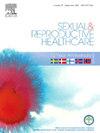pre-SUCCECS:在剖腹产过程中使用完整脐带实施复苏和稳定的经验教训-与实施小组的焦点小组讨论
IF 1.7
3区 医学
Q3 PUBLIC, ENVIRONMENTAL & OCCUPATIONAL HEALTH
引用次数: 0
摘要
目的本研究的主要目的是探讨在紧急剖宫产手术中对需要复苏或稳定的早产儿和足月儿实施完整脐带复苏和稳定程序的经验教训。方法采用2次焦点小组讨论和1次个人访谈法收集资料。参与者是实施小组的成员,负责在剖宫产期间使用完整脐带实施复苏和稳定。执行小组来自瑞典不同大都市地区的两家医院。在实施研究统一框架2.0的指导下,我们使用了数据收集和分析的演绎法和归纳方法来得出经验教训。结果除外部设置外,所有实施域均在结果中表示。执行小组描述了对诸如保持无菌、新生儿温度控制和设备可用性等共同关切的建议解决办法。此外,与会者强调了由所有专业代表组成的多学科实施团队的重要性,以及团队中有决策权的必要性,以便成功实施。结论:在剖宫产过程中使用完整脐带实施新生儿复苏和稳定的经验教训可以为在不同分娩环境中实施这一复杂干预的临床常规提供有效的策略。在紧急剖宫产术中使用完整脐带实施复苏和稳定的经验教训也包括在内。提出了可能的解决方案,以关注无菌,新生儿体温控制和设备的可用性。本文章由计算机程序翻译,如有差异,请以英文原文为准。
pre-SUCCECS: Lessons learned from implementing resuscitation and stabilisation with an intact cord during caesarean sections – Focus group discussions with implementation teams
Objective
The primary aim of this study was to explore the lessons learned from implementing a procedure of resuscitation and stabilization with an intact umbilical cord for preterm and term infants requiring resuscitation or stabilization during emergency caesarean sections.
Methods
Data were collected by two focus group discussions and one individual interview. Participants were members of implementation teams responsible for implementing of resuscitation and stabilization with an intact cord during caesarean sections. The implementation teams were from two hospitals from different metropolitan areas in Sweden. We used a deductive approach with data collection and analysis guided by the Consolidated Framework for Implementation Research 2.0 and an inductive approach to derive lessons learned.
Results
All implementation domains except the outer setting were represented in the results. Suggested solutions to common concerns such as maintaining sterility, temperature control of the neonate and availability of the equipment were described by the implementation teams. Additionally, the participants highlighted the importance of a multidisciplinary implementation team with all professions represented as well the need for decision-making authority in the team, for successful implementation.
Conclusions
The lessons learned from implementing neonatal resuscitation and stabilisation with an intact umbilical cord during caesarean section can inform efficient strategies for implementing this complex intervention into clinical routines across difverse birth settings.
Synopsis
Lessons learned from implementing resuscitation and stabilization with an intact cord during emergency caesarean sections are included. Possible solutions to concerns about sterility, neonatal temperature control, and equipment availability are presented.
求助全文
通过发布文献求助,成功后即可免费获取论文全文。
去求助
来源期刊

Sexual & Reproductive Healthcare
PUBLIC, ENVIRONMENTAL & OCCUPATIONAL HEALTH-
CiteScore
2.70
自引率
5.60%
发文量
73
审稿时长
45 days
 求助内容:
求助内容: 应助结果提醒方式:
应助结果提醒方式:


